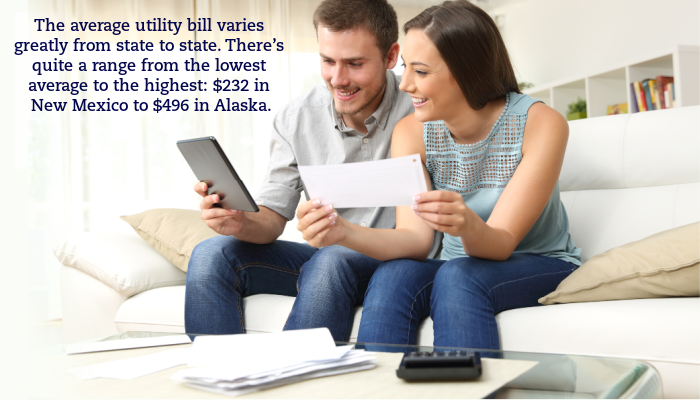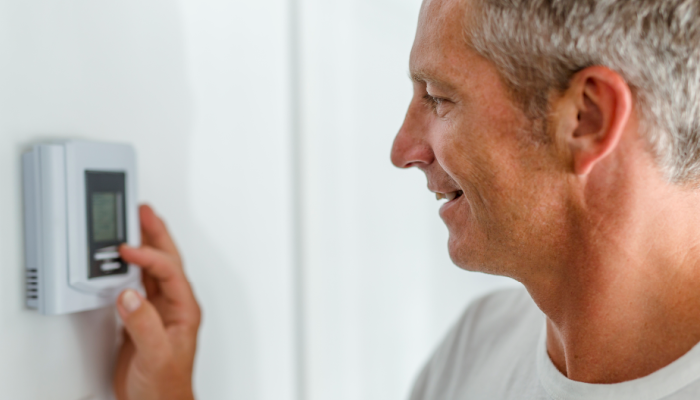For many apartment dwellers, “rent & utilities” is the largest line item in their budget. Although it is easy to fill in the rent amount, calculating utilities is another matter. Electricity and natural gas usage often vary a great deal throughout the year. A utility bill in the summer may be very different from one in the winter. Other utilities, like cable, landlines, and cellphone service, are optional.
Read on to learn more about your apartment utility bill, how to calculate your monthly utility bill, and what you can do to reduce your utility expenses.
What Are the Most Common Utilities?
When thinking about utilities, tenants usually think about the electric bill first. Almost all renters pay for their own electricity. Some also pay for natural gas. Cable TV and internet service are usually a part of a renter’s utilities expense as well. When it comes to telephone service, some still pay for a landline. Others rely on their cellphone.
Electricity bills often include a basic facility fee or customer service charge. Electricity delivered to residences is measured in kilowatt-hours (kWh). A kilowatt-hour is the amount of electricity needed to light ten 100-watt incandescent light bulbs for one hour.
Bills often compare usage to the same month the previous year. This makes it possible to gauge your progress in saving energy from last year to this year.
Many residents also receive a bill for natural gas, measured in therms. One therm equals 100,000 British Thermal Units (BTU) of energy. In many apartment buildings, natural gas fuels the heating system. It often powers hot water heaters and heats stoves, as well. Frequently, a gas bill compares usage to the same month of the previous year. It may also list the average temperature for the month, so you can see how a cold snap impacts your bill, for example. Some bills will even list monthly usage for the previous 12 months.
Some utility companies combine electric and natural gas charges on one monthly bill. These services are subject to state and local sales taxes.
With every utility, always be clear about who pays for what. Landlords often take care of water, sanitary sewer, and garbage collection. Still, residents may pay for one or more of these services. They might pay directly or in the form of a fee charged by the landlord. For example, the property’s overall water bill might be divided by the number of tenants.

What Does the Average Renter Pay in Utilities?
The average utility bill varies greatly from state to state. RentCafe provides an interactive map that calculates average utilities by state. There’s quite a range from the lowest average to the highest: $232 in New Mexico to $496 in Alaska. In many states, the average is $250 to $300. Adjust these figures downward if the landlord pays for certain utilities, like sewer and water.
RentCafe calculates cable TV and internet at $70-100 in many states. Another source estimates cable TV and internet at $145. Premium cable TV packages and ultra-high-speed internet tend to increase costs. As an alternative to cable TV, some residents turn to streaming services instead to cut costs.
Many renters now find themselves working at home due to COVID-19. This means that they’re spending a lot more time at home. In the office, employers pay to keep employees comfortable. Now, work-from-home employees may face higher utility bills.
What Factors Influence the Cost of Utilities?
A renter’s total cost of utilities is often impacted by:
- Regional climate: There are significant regional variations in heating and cooling costs. Keep in mind that heating an apartment often costs more than cooling it–sometimes much more. For example, high air conditioning costs incurred during a Texas summer are offset by lower heating costs in the winter.
- Apartment size and number of bedrooms: Naturally, a smaller apartment costs less to heat and cool. These costs can 40-70 percent higher in a three-bedroom than a studio apartment.
- Energy efficiency: The nature of the apartment building affects utility costs. Newer or renovated apartment buildings often feature energy-efficient HVAC systems and appliances. They are often better insulated as well. Lower electric and gas bills may offset some of the higher rents of more modern units.
- Time spent at home times the number of occupants: A three-bedroom apartment shared by three roommates is often a bustling place. The more time spent in the apartment, the higher the heating and cooling costs tend to be. Also, the lights are on more, and the dishwasher runs more. However, roommates often split the utility bill.
Many renters now find themselves working at home due to COVID-19. This means that they’re spending a lot more time at home. In the office, employers pay to keep employees comfortable. Now, work-from-home employees may face higher utility bills.
Tips for Reducing Your Electricity Bill
Some renters find that their electric bills soar in the summer. Those working from home may use more air conditioning than ever before. A thermostat set to 77 degrees °F balances comfort with energy savings.
In the summer, your air conditioned apartment is a haven for cool, comfortable air. Reduce the greenhouse effect by closing window treatments, particularly those on south-facing walls. Don’t open exterior doors any more than necessary. Ensure that windows are completely closed and only open them when the nights are cool.
Select the “reverse” setting on a ceiling fan so it pulls warm air upward. Ceiling fans make it possible to raise your thermostat setting by as much as four degrees, according to EnergyStar, which can add up to big savings overtime.
Open and close interior doors and registers to guide the cooled air where you want it the most. Unrestricted airflow is important. Don’t block a register with furniture, for example. Guide cooled air to your work-from-home area during the day and to your bedroom by night for maximum comfort.
Look for cracks and crevices that might be letting the hot air and humidity in. Caulking or otherwise sealing these gaps improves indoor comfort while reducing energy costs. Lastly, be sure to minimize your use of heat-generating appliances. Cut the use of your stove or in-unit clothes dryer during the day and replace hot incandescent light bulbs with cool-running LEDs.
Find Your Next Apartment Today
If you’re looking for your next apartment, be sure to check out Draper and Kramer’s portfolio of luxury apartments by visiting draperandkramer.com today.

When thinking about utilities, tenants usually think about the electric bill first. Almost all renters pay for their own electricity. Some also pay for natural gas. Cable TV and internet service are usually a part of a renter’s utilities expense as well.